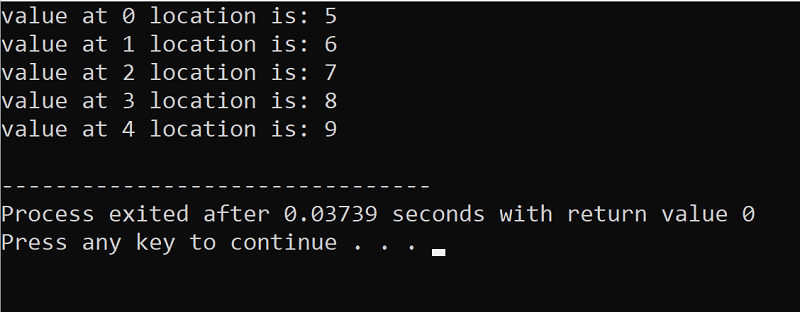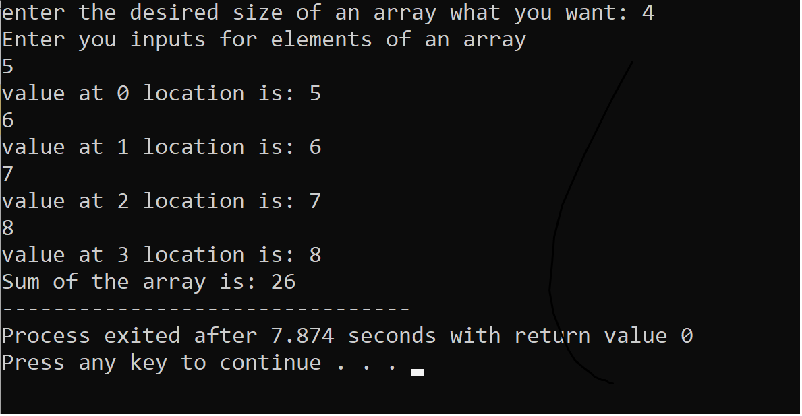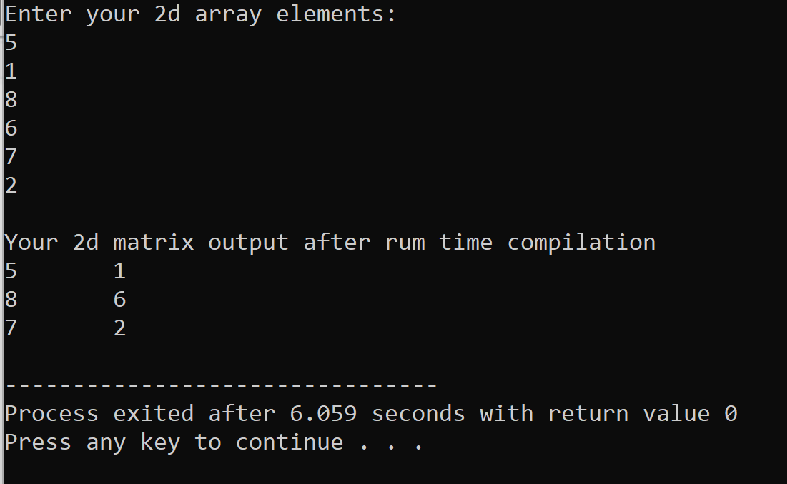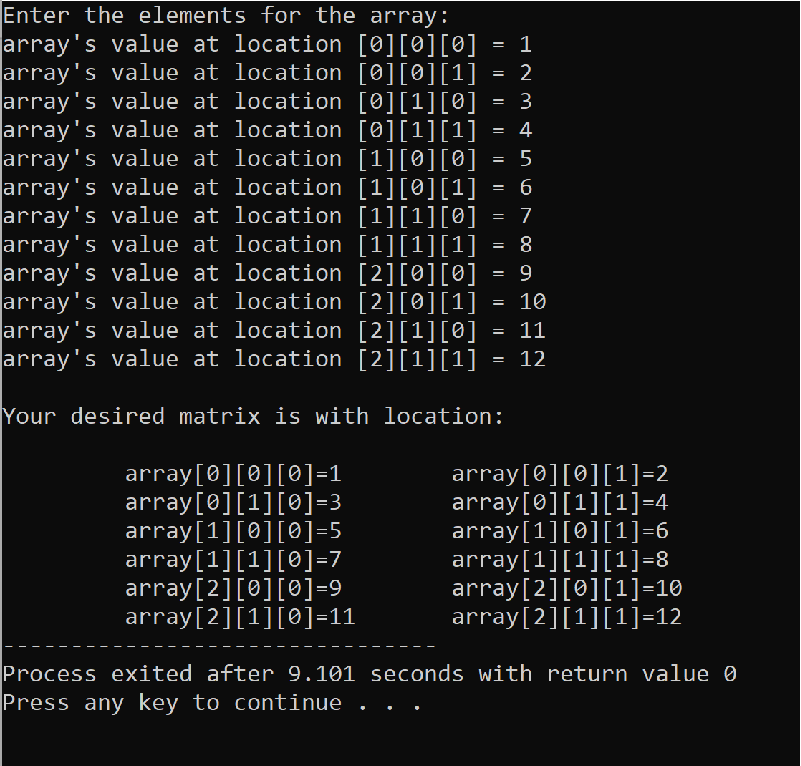Types of Array in C
What is an Array?
One value can be stored in a variable at once. How many variables will you need if you have 100 values? Well, the answer isn't 100. It is 1, and it can be done with the help of variable is an Array.
An array is a collection of similar types of data. These similar data can be anything, for example, the Name of 10 players, the Percentage of 50 students, or the Salary of 100 students.
It is a linear data structure that stores elements or data in the contiguous memory location.
We can access the elements of an array using an index. For arrays in C, the index starts at 0.
Note: A character array is referred to as a "string," but an array of int or float is referred to as a simple array.
Types of Array
In C programming, there are three different types of arrays:
1. One Dimensional Array
2. Two-Dimensional Array
3. Multi-Dimensional Array
Let’s discuss each of them:
1. One Dimensional Array (1D):
An array that is displayed as one row or one column is referred to as a one-dimensional array.
One Dimensional Array is a type of array that allows for the arrangement of data in a single dimension.
A one-dimensional array is one in which each element of the array can be specified by a single subscript statement.
It is a structured group of elements that may be accessed separately by designating the position of each element with a single index value.
Declaration of One-Dimensional Array:
In C, a one-dimensional array can be declared as:
Data_Type Array_name[Arraysize];
Data_Type:
It essentially represents the data type of the elements that are kept in the contiguous memory location. For example, if we want to store characters, then we need to use char data type.
Array_name:
This is the name of an array that is given by us. It can be like arr, age, boys, etc.
[Arraysize]:
This illustrates how many elements an array can store in contiguous memory. This Arraysize value must be more than zero and be an integer constant.
For example:
char student_name[15] ;
Here char is the data type of student_name.
student_name is the array‘s name.
The size of the array is 15, which means we can store only 15 characters in this student_name array.
Rules for declaring one dimension array:
- An array must be declared before using it in the program.
- The declaration must include a data type and an appropriate array name. for example, we use the int data type for integer elements.
- The declaration must have subscript.
- The subscript represents the size of an array. If we declared the size like 15, it means now we can store only 15 elements.
- An array index must start with Zero. For instance, the range of the index in Arr[15] is 0 to 14.
- Each element of an array should be stored in a different part of the memory.
Initialization of One-dimensional array:
A one-dimensional array can be initialized in two ways.
- At compile time (Static allocation)
- At the run time (Dynamic allocation)
Compile time Initialization:
At the time of declaration, we can initialize the array. This type of initialization is called compile time initialization.
The syntax for initializing an array at compile time:
Data_type Array_name[size] = {list of values};
So, we assign the value to the array using curly braces. In this curly brace, we put our list of values.
Initializing all of the specified memory locations:
When the starting values of an array are known before it is declared, they can be initialized.
Such as: int Arr[4]={5,6,7,8}
For the variable Arr, the compiler reserves 4 contiguous memory spaces during compilation, and all of these areas are initialized as indicated in the figure below.
| Index | 0 | 1 | 2 | 3 |
| Element | 5 | 6 | 7 | 8 |
- Initializing a partial array:
The C programming language supports partial array initialization if there are fewer values to initialize than there is space in the array.
After that, the elements of a numeric array will automatically be initialized to zero, whereas those of a non-numeric array will be initialized with a space.
Such as: int Arr[4]={0};
| Index | 0 | 1 | 2 | 3 |
| Element | 0 | 0 | 0 | 0 |
- Without Size, initialization:
Take into account both the declaration and the initialization.
For example, char vowel[]={‘a’, ‘e’, ‘i’, ‘o’, ‘u’};
Although we haven't given a precise amount of elements to be used in array vowels in this declaration, the total number of initial values supplied will determine the size of the array. As a result, 5 will automatically be assigned as the array size.
The following figure illustrates how the array vowel is initialized:
| Index | 0 | 1 | 2 | 3 | 4 |
| Elements | a | e | i | o | u |
- String-based array initialization:
Take into account the string initialization in the declaration.
For example, char name[]={“Gopal”}
The following figure illustrates how the array name is initialized:
| Index | 0 | 1 | 2 | 3 | 4 | 5 |
| Elements | G | o | p | a | l | \0 |
Because it is a string, the word "Gopal" ends with a null character, even if it has five letters. The array's size is 6 bytes means an extra string length of 1 byte will be available for the null character.
Program:
#include<stdio.h>
int main()
{
int i;
int Arr[5] = {5, 6, 7, 8, 9}; // Compile time array initialization
for(i = 0 ; i < 5 ; i++)
{
printf("value at %d location is: %d\n", i, Arr[i]);
}
return 0;
}
Explanation:
- Here we have Arr variable name array, which has an int data type,
- This array size is 5.
- We have one more variable, “i,” which also has an int data type.
- We initialized our array at the time of declaration means at compilation time.
- The value assigned to the array is 5, 6, 7, 8, and 9, which is assigned at different memory locations according to their subscript.
- When for loop run and the condition is satisfied then our printf() function will run.
- In this output, we get to know our value and as well as about the index of values.
Program Output:

Run Time Initialization:
We can initialize an array at the run time. In another word, we initialize an array’s elements after the compilation.
We can initialize the large array using this approach.
We also used to fill the empty array with data entered by the user.
The user can accept or enter alternative values during various program runs using runtime initialization.
Using the scanf() function, an array can be initialized dynamically.
For example:
int a[2];
scanf(“%d,%d”, &a[0], &a[1]);In the above example, we entered the value through the keyboard. This way, we initialize this array at run time using scanf().
Program:
#include <stdio.h>
int main()
{
int i,size,sum;
printf("enter the desired size of an array what you want: ");
scanf("%d",&size);
sum=0;
//Declaration of an array
int Array[size];
printf("Enter you inputs for elements of an array\n");
// Input the elements of an array
for( i=0;i<size;i++)
{
scanf("%d",&Array[i]);
printf("value at %d location is: %d\n", i, Array[i]);
sum = sum+Array[i];
}
//Print sum
printf("Sum of the array is: %d",sum);
return 0;
}Explanation:
- Three variables—i, size, and sum—with the int data type are present.
- We initialized our array at runtime with the aid of the scanf() method.
- We used the keyboard to enter the array size value and stored it in the size variable.
- We declare our array as a variable with the name Array and an int data type.
- With the condition that “i” must be less than the "size variable," we initialize ”i” to zero.
- If this statement is true, the loop will continue; otherwise, it will end.
- Using the keyboard, we entered the array's elements and stored them in Array[i].
- Then, make the sum variable equal to the sum plus the array element “i,”. i.e. sum= sum+Array[i].
- After that, print the array's sum.
Program Output:

Accessing Elements of a One Dimensional Array:
Utilizing the array name and subscript or index enclosed in a pair of square brackets, we can retrieve an array element []. As we know very well, the indexing of an array begins at 0. Index N-1 corresponds to the array's Nth element.
For example, We have an array with 6 elements with the char data type.
Char name[6]={‘M’, ‘A’, ‘Y’, ‘A’, ‘N’, ‘k’};
Using an array name, we can now access the elements of the array name.
1. name[0] = First element of array name is ‘M’
2. name[1] = Second element of the array name is ‘A.’
3. name[2] = Third element of the array name is ‘Y.’
4. name[3] = fourth element of array name is ‘A.’
5. name[4] = Fifth element of the array name is ‘N.’
6. name[5] = Sixth element of the array name is ‘k.’
Assigned the value to the Array’s Element:
Using the assignment operator, values can be given to each element in an array.
Syntax: Array_name[index]=value;
For example: Arr[5]=10;
Arr[0]=100;
By only assigning one element to another array, we cannot duplicate all of the elements in one array to the second array.
For example:
If we have two arrays like X[4] and Y[4], then
int X[4]={5,6,7,8} ;
int Y[4];
if we initialize both Array X and Y with an assignment operator like this, X=Y;
So, this way, we can not duplicate all of the elements in the X array to another array, Y.
We can copy all of the elements in one array to another array using the loop.
Like this
i=0;
While(i<4)
{
X[4]=Y[4];
i++;
}2. Two-Dimensional Array (2d Array):
We have discussed array variables that can store a list of values. A table of values may need to be stored in some circumstances. Using two-dimensional arrays, C enables us to create object tables.
Two-dimensional arrays are represented in C as rows and columns, sometimes known as a matrix.
The row and column are indicated by one subscript, while the array is specified using two subscripts.
A 2D array is also known as the Array list or Array of arrays.
Declaration of Two-Dimensional Array:
We can declare our 2D array in this way,
Syntax:
Data_type Array_Name[row_size][column_size];
Data_type:
It is essential to represent the data type of Array’s elements present in the contiguous memory location.
Array_Name:
This is the array's variable name. Without this variable name, we would be unable to discover our data to store them, which is equally crucial.
[row_size][column_size]:
For a two-dimensional array, the declaration of the rows and columns is required.
We cannot change the row size to a column size or vice-versa. It is necessary to keep the correct order.
For example:
Int X[3][3];
Variable X has been given a memory of the data type int.
We have 3 rows and 3 columns which will make a 3*3 matrix.
| X[0][0] | X[0][1] | X[0][2] |
| X[1][0] | X[1][1] | X[1][2] |
| X[2][0] | X[2][1] | X[2][2] |
Through the form shown above, it is possible to retrieve the array's data. The first square bracket in a 2-D array representation denotes the number of rows, and the second one the number of columns. For the first element of the array, the index representation always begins at zero and ends at size-1. Internal pointer variables, like X in this example, always contain the base address of the memory block.
Thus, if there are three rows, for instance, the index representation for accessing the data in the rows will be 0, 1, and 2. The column indexes also follow the same logic. For the above illustration, to obtain the data for the third row and the third column, we can access X[2][2].
Initialization of Two-dimensional array:
The two-dimensional array can be initialized in the same manner as the one-dimensional array.
- At compile time (Static allocation)
- At the run time (Dynamic allocation)
Compile time Initialization:
The 2D array's elements can be declared in the same way as regular variables are. The matrix form is the most effective way to begin a 2D array.
Syntax:
Char car[3][2]= {
{‘a’, ‘e’},
{‘I’, ‘o’},
{‘u’, ‘j’}
};
//We can also initialize in this way
Char car[3][2] = {‘a’, ‘e’, ‘I’, ‘o’, ‘u’, ‘j’};
But in this, we lost our readability.Here we specify the no of rows and no of columns which is 3 and 2, respectively. These rows and columns make a 3*2 matrix.
Note: In contrast to the first dimension (row), which is optional, the second dimension (column) must be mentioned when initializing a 2-D array.
int[2][3]={11,12,13,15,16,18};
int[][3]= {11,12,13,15,16,18};
Whereas
int[2][]= {11,12,13,15,16,18};
int[][]={11,12,13,15,16,18};
It would never work.
Program:
#include <stdio.h>
int main()
{
char abc[3][2]= {
{'a', 'e'},
{'i', 'o'},
{'u', 'j'}
};
char i,j;
for(i=0;i<3;i++)
{
printf("\n");
for(j=0;j<2;j++)
printf("%c\t",abc[i][j]);
}
return 0;
}Explanation:
- In above code, we declared a two-dimensional array with three rows, two columns, and array name “abc”, which has a char data type. Three rows and two columns make up this 3*2 matrix.
- We have 2 variables, “i” and “j,” with the char data type.
- We initialized our array at compile time.
- Our matrix row is accessed using “i”.
- Since we initialized “i” to 0 in the outer loop, which means it will firstly access the first row.
- Then we have an inner loop iterating over “j” and accessing columns in this loop.
- Consequently, we traverse over j for the first row's i = 0(from 0 to 2).
- The value of “i” is already fixed at 0 when we started the inner loop, and we now cycle over j while continuously increasing the values.
- So we have abc[0][0], then we increment y by 1 to access abc[0][1] ,then again increment to access abc[0][2].
- When j = number of columns, we exit from the inner loop. We examine the state of the outer loop. If i = number of rows, the loop is ended; otherwise, it is restarted with an increased “i”. We have accessed every component of a matrix in a similar manner.
Program Output:

Run Time Initialization:
We utilized looping statements to set the array's values one at a time, much like when we initialized a 1D array.
Similar to how a 2D array is initialized, a looping structure is used.
The 2D array will be initialized using a nested loop structure, with an outer for loop for the rows (first sub-script) and an inner for loop for the columns (second sub-script).
Syntax:
for(x=0; x<3;x++)
{
for(y=0; y<2; y++)
{
scanf("%d", &abc[x][y]);
}
}
printf("\n");We access the matrix's (a 2D array) row using the first for loop, then use the inner for loop to scan each column.
Our matrix's rows are accessed using i. Since we initialized x to 0 in the outer loop, we will be accessing the first row. We now have an inner loop iterating over y and accessing columns in this loop. Consequently, we traverse over y for the first row's x = 0, which (from 0 to 3). The value of x is already fixed at 0 when we start the inner loop, and we now cycle over y while continuously increasing the values.
So we have a[0][0], then we increment y by 1 to access a[0][1] ,then again increment to access a[0][2], so by incrementing of y we can reach the a[0][3].
Program:
#include<stdio.h>
int main()
{
int abc[3][2];
int x, y;
printf("Enter your 2d array elements:\n");
for(x=0; x<3;x++)
{
for(y=0; y<2; y++)
{
scanf("%d", &abc[x][y]);
}
}
printf("\n");
printf("Your 2d matrix output after rum time compilation\n");
for(x=0; x<3; x++)
{
for(y=0; y<2; y++)
{
printf("%d\t", abc[x][y]);
}
printf("\n");
}
return 0;
}Explanation:
- In the above code statement, we declared a two-dimensional array with three rows, two columns, and the variable “abc”, which has an int data type. Three rows and two columns make up this 3*2 matrix.
- We have 2 variables, “x” and “y,” with the int data type.
- With the help of the first for loop, we access the matrix's (2D array) row and then use the inner for loop to explore each of its columns.
- With the help of the scanf() function, we initialize our 2d array at run time.
- Our matrix row is accessed using “x”.
- Since we initialized “x” to 0 in the outer loop, we are now accessing the first row.
- We now have an inner loop iterating over “y” and accessing columns in this loop.
- Consequently, we traverse over y for the first row's x = 0, which (from 0 to 2).
- The value of “x” is already fixed at 0 when we start the inner loop, and we now cycle over “y” while continuously increasing the values.
- So we have abc[0][0], then we increment y by 1 to access abc[0][1] ,then again increment to access abc[0][2].
- When y= number of columns, we exit the inner loop. We examine the state of the outer loop. If x = number of rows, the loop is ended; otherwise, it is restarted with an increased “x”. We have access to every component of a matrix in a similar manner.
- This way, we can access the whole matrix and get our desired output.
Program output:

3. Multi-dimensional Array:
Multi-dimensional arrays are those that contain multiple subscript variables or subscript indexes.
Arrays of arrays make up a multidimensional array.
In other words, an array that has multiple dimensions like two, three, or four, etc., is known as multiple dimensional array.
Multi-dimensional arrays can be 2D, 3D, 4D, or more.
Declaration of Multi-dimensional Array:
In C programming, a multi-dimensional array is declared as:
Syntax: Data_type Array_Name[size1][size2]…[sizeN];
Data_type:
It is essential to represent the data type of Array’s elements present in a contiguous memory location.
Array_Name:
This is the array's variable name. Without this variable name, we would be unable to discover our data to store them, which is equally crucial.
[size1][size2]…[sizeN]:
With the help of this, we can decide on our multi-dimensional array.
By multiplying the sizes of all the dimensions, it is possible to determine the overall number of elements that may be held in a multidimensional array.
Initialization of Multi-dimensional Array:
Initialization of a multi-dimensional array is also similar to a two-dimensional array. To differentiate, we increase the number of nested braces by adding more dimensions, such as 3D or 4D.
For example:
int abc[2][3][4] =
{
{ {1,3,5,7}, {9,11,13,15}, {17,19,21,23} },
{ {25,27,29,31}, {33,35,37,39}, {41,43,45,47} }
};Program:
#include <stdio.h>
int main()
{
int abc[3][2][2],x,y,k;
printf("Enter the elements for the array:\n");
for(x=0;x<3;x++)
{
for(y=0;y<2;y++)
{
for(k=0;k<2;k++)
{
printf("array's value at location [%d][%d][%d] = ",x,y,k);
scanf("%d",&abc[x][y][k]);
}
}
}
printf(" \nYour desired matrix is with location:\n");
for(x=0;x<3;x++)
{
printf("\t");
for(y=0;y<2;y++)
{
printf("\n");
for(k=0;k<2;k++)
printf("\t array[%d][%d][%d]=%d",x,y,k, abc[x][y][k]);
}
}
}Explanation:
- In above code, we declared a multi-dimensional array with three tables, two rows, two columns, and the variable “abc”, which has an int data type. Three tables, two rows, and two columns make up this 3*3*3 matrix.
- We have 3 variables, x,y, and k, which represent tables, rows, and columns, respectively.
- Firstly “x” iteration will start.
- The value of “x” will be 0, and the condition (x<3) is true. So, it will enter into the second for loop (“y” Iteration).
- The value of the “y” will be 0, and the condition (y < 2) is True. So, it will enter into the third for loop (“k” Iteration).
- The value of the “k” will be 0, and the condition (k < 2) is True. So, it will start executing the statements inside the loop until the condition fails.
- We have accessed every component of a matrix in a similar manner, then we get our desired matrix.
Program Output:
